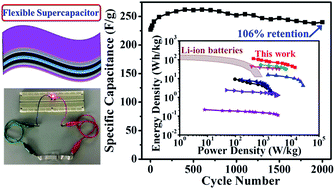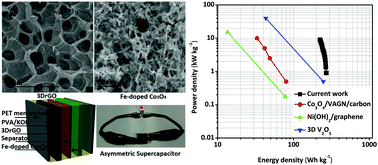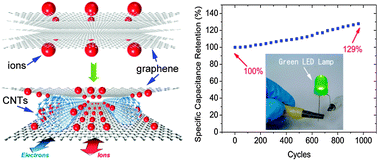The chargedischarge data show graphene supercapacitor by availing high 2 v stable potential window in ionic liquid electrolyte gel greatly boosted the energy density to 333 whkg1 at. The use of curved graphene is one of the key factors in achieving the superior energy density of our ultracapacitors.

A Freestanding Cellulose Nanofibril Reduced Graphene Oxide

Graphene Based Supercapacitor With An Ultrahigh Energy

Nitrogen Doped Graphene As Electrode Material With Enhanced
The previous reported gravimetric energy density values of graphene supercapacitors are among 2090 wh kg 1 at 1 a g 1 14 24 25 66 and the volumetric energy density values are in the range of 1362568 mwh cm 3 for supercapacitors with no special compression methods applied 14 24 25.

Graphene ultracapacitor energy density. Skelcap ultracapacitors have up to two times higher energy density compared to even the most advanced cells produced by our competitors. The low power density may indicate that it is in fact a hybrid supercapacitor battery or a pseudo supercapacitor. A supercapacitor also called an ultracapacitor is a high capacity capacitor with a capacitance value much higher than other capacitors but with lower voltage limits that bridges the gap between electrolytic capacitors and rechargeable batteries.
It typically stores 10 to 100 times more energy per unit volume or mass than electrolytic capacitors can accept and deliver charge much faster than batteries and tolerates many more charge and discharge cycles than rechargeable batteries. A supercapacitor with graphene based electrodes was found to exhibit a specific energy density of 856 whkg at room temperature and 136 whkg at 80 0c all based on the total electrode weight measured at a current density of 1 ag. A supercapacitor 28v 30000 farads in graphene nano hybrid with an energy density of 21 wh kg and a power density of 2 kw kg.
The surface area of a single graphene sheet is 2630 m 2 g substantially higher than values derived from bet surface area measurements of activated carbons used in current electrochemical double layer capacitors. Graphene could therefore be used to make supercapacitors that hold more energy per kilogram than lithium ion batteries. And since its only one atom thick you can pack a ton of surface area into a small space.
These energy density values are comparable to that of the ni metal hydride battery. Graphene is to graphite what a single playing card is to a full pack. Graphene has an area of 2675 square metres per gram.
All of this surface is available for the storage of static electricity. It has the same energy density as lithium ion batteries with the power density of super capacitors.

High Performance Asymmetric Supercapacitors Based On Dual

Thiolated Graphene Based Supercapacitors With High Energy

A Fiber Supercapacitor With High Energy Density Based On

Pdf Towards Enhanced Energy Density Of Graphene Based

Water Dispersible Graphene Polyaniline Composites For

Graphene Supercapacitors Are 20 Times As Powerful Can Be

Ultrahigh Energy Density Battery Type Asymmetric

All Solid State Asymmetric Supercapacitors Based On Fe Doped

Graphene And Carbon Nanotube Composite Electrodes For

Supercapacitor Wikipedia

A Ragone Plot Of Areal Energy Density Versus Areal Power

Supercapacitor Wikipedia
Comments
Post a Comment